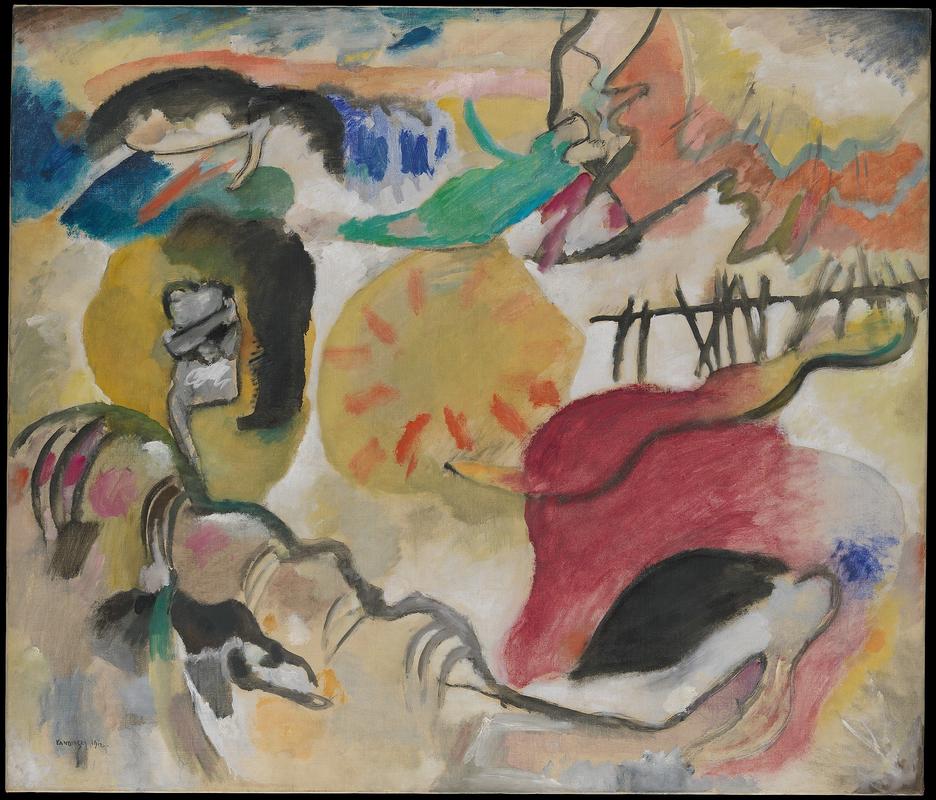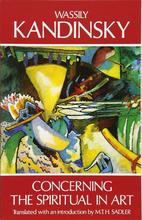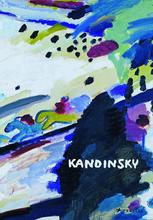More about Improvisation 27 (Garden of Love II)
- All
- Info
- Shop

Contributor
Kandinsky did improv, but not stand-up
You have to admire a guy who does improv. In this case, it’s no joke. Wassily Kandinsky spent a lifetime trying to capture music visually in a painting by “improvising” more than two hundred works. He even did “studies” for his Improvisations—which, if you ask me, is more “totally scripted” than “improv.” Amiright?
In Improvisation 27, there’s more than just a mood going on even though Kandinsky suggested you should look for mood and not necessarily objects in his paintings. He even gives us a hint in the subtitle, Garden of Love II.
At first we notice what looks like a landscape—clearly there is a sun in the middle (can’t miss those orange spokes!), a black pointy fence, and some rolling mountains. Is that a waterfall at the top? A little harder to see are three sets of lovers defying gravity around the sun: an embracing couple to the left of the sun, a green and red couple sitting atop the sun, and at the bottom right, a black figure on top of a white figure. We got here an abstract orgy.
But wait! It ain’t all fun and games in the Garden of Love. Reminding us of what happened in the Garden of Eden, he added a long black, snake-like line crawling across the canvas. Alas, the sexy-time could come to a violent end. And to drive that point home are black clouds cloaking the embracing couple on the left. And another figure—perhaps God?—reaches down, threatening to break up the party.
Is the painting improvisational? No. Is it moody and representational? Yes. So Mr. Kandinsky, you didn’t exactly practice what you preached. Either way, the painting crossed the ocean in 1913 to the new world for the first, seminal International Exhibition of Modern Art in New Yorks City—the show we now lovingly call The Armory Show. But back then, most people didn’t get the European avant-garde. Even President Teddy Roosevelt wrote in Outlook Magazine, “In this recent art exhibition the lunatic fringe was fully in evidence.” Hey, hey, Mr. President! Only artists can call themselves lunatics!
Like most artists, Kandinsky wasn’t looking for approval but for some cold hard cash. Thankfully for him, the photographer, collector and dealer (and George O’Keeffe’s guy), Alfred Stieglitz, purchased this painting even though he had no intention of purchasing anything at the Armory show. He later wrote Kandinsky: “I was so insenced [sic] at the stupidity of the people who visited the Exhibition, and also more than insen [sic] at the stupidity of most of those in charge of the Exhibition, in not realizing the importance of your picture that I decided to buy it.”
When you’re standing in front of “Improvisation 27 (Garden of Eden II)” at the Met, you might want to test if Kandinsky successfully captured the musicality of the sexy mood while listening to Marvin Gaye’s Let’s Get it On.
Sources
- http://metmuseum.org/art/collection/search/488319
- http://www.metmuseum.org/toah/works-of-art/49.70.1/
- http://armory.nyhistory.org/i-decided-to-buy-it-alfred-stieglitz-at-the…
- http://www.theodore-roosevelt.com/images/research/treditorials/o183.pdf
- http://xroads.virginia.edu/~MUSEUM/Armory/galleryG/tour.g.html
- https://books.google.com/books?id=jv5NB7hRJXUC&printsec=frontcover#v=on…













